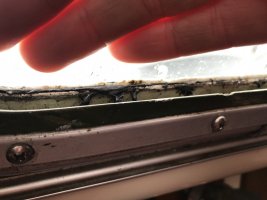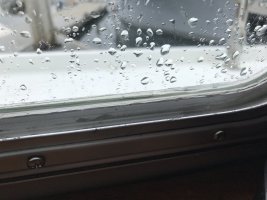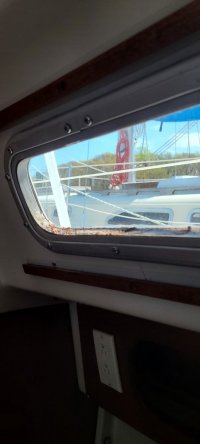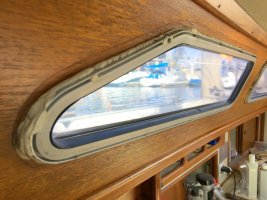LeifThor
Member III
It can be a tough decision, reseat or buy new portlights. If I could afford it, I’d probably go with Bomar who are recommended by many on this site. But at $300 a pop, and after spending $3,800 on a haul out for leak repairs and a couple new throughhulls and valves, the piggy bank was broke for now, so in an ongoing attempt to find and seal every leak on my 1972 E 35-2, I decided it was time to take on the windows.
I’ve learned after many mistakes with boat repairs, it’s always better to start and finish one instead of pulling all only to find issues. Better to use the first as a means to find the best solutions and then the others should go more easily.
Took about 30 min to remove the port light, and then had to decide to just reseat the gasket between port light and hull, or pull the whole thing apart and reseat the whole thing.
The problem was when I took the unit off the boat, the material that was used as the gasket before, was a tar like substance somewhere between tar and caulking, and without a doubt was the worst material I’ve ever had to work with. Still wet it got everywhere. Anything that touched it required Acetone to remove it. And I was pretty sure they used the same tar-like material in between the glass and the frame. I have never in my life worked so hard to remove the material in an object 6“ x 14”. I tried acetone, I tried digging it out with a screwdriver or a paint scraper. Then I moved on to trying to take it out with paint remover. The paint remover did remove the paint on the outside of the frame, but only turned the tar like substance more gooey making it even worse to try and remove.
After spending two full days trying to get these frames clear of this material, I had a moment of clarity. Sitting there exhausted looking at this frame with the material inside no matter what I did it just wouldn’t quite come out, I just kept saying to myself tar, the last idiot who put anything on these windows used tar to seal them. Tar, just like tar at the beach that gets stuck on your foot. And then it hit me!
Sand! Sand would be the one thing that could remove this impossible material. This tar-like material, it’s biggest problem was that it stuck to everything. So if I just shoved it in a bucket of sand and kept rubbing it eventually it would stick to enough sand that it would clean it.
I went and got a bucket of sand from the beach, and was totally stoked to discover not only could it clean the tar out, but it actually worked really well at buffing and cleaning the aluminum!
It turned 40 hours of work on one window, into 10 for all future windows with this terrible material in it. I only have pictures after using the sand but if I do another windows soon I’ll upload the before and after pictures so you get an idea of how terrible these port lights were.
I used butyl tape to reseal the port light, and I used butyl tape as the gasket between the unit and the hull. I won’t do any more windows until after a really good rain or testing it with a hose on it to make sure this is a good seal solution.
Anyone who has used butyl tape will tell you, it’s great stuff to work with it’s like silly putty. And it holds a seal really well over a long period of time. And if you need to change the unit or remove it comes right off.
So if your having a hard time with the project, Sometimes it works to really think outside of the box. Any sailor I’ve mentioned my sand solution to, has just looked at me with a raised eyebrow and said wow that’s a really good solution. It’s also more environmentally conscious, or at least I think so. Please tell me if I’m wrong on that.
I hope this post helps anyone who is considering repairing instead of replacing your port lights.
I’ve learned after many mistakes with boat repairs, it’s always better to start and finish one instead of pulling all only to find issues. Better to use the first as a means to find the best solutions and then the others should go more easily.
Took about 30 min to remove the port light, and then had to decide to just reseat the gasket between port light and hull, or pull the whole thing apart and reseat the whole thing.
The problem was when I took the unit off the boat, the material that was used as the gasket before, was a tar like substance somewhere between tar and caulking, and without a doubt was the worst material I’ve ever had to work with. Still wet it got everywhere. Anything that touched it required Acetone to remove it. And I was pretty sure they used the same tar-like material in between the glass and the frame. I have never in my life worked so hard to remove the material in an object 6“ x 14”. I tried acetone, I tried digging it out with a screwdriver or a paint scraper. Then I moved on to trying to take it out with paint remover. The paint remover did remove the paint on the outside of the frame, but only turned the tar like substance more gooey making it even worse to try and remove.
After spending two full days trying to get these frames clear of this material, I had a moment of clarity. Sitting there exhausted looking at this frame with the material inside no matter what I did it just wouldn’t quite come out, I just kept saying to myself tar, the last idiot who put anything on these windows used tar to seal them. Tar, just like tar at the beach that gets stuck on your foot. And then it hit me!
Sand! Sand would be the one thing that could remove this impossible material. This tar-like material, it’s biggest problem was that it stuck to everything. So if I just shoved it in a bucket of sand and kept rubbing it eventually it would stick to enough sand that it would clean it.
I went and got a bucket of sand from the beach, and was totally stoked to discover not only could it clean the tar out, but it actually worked really well at buffing and cleaning the aluminum!
It turned 40 hours of work on one window, into 10 for all future windows with this terrible material in it. I only have pictures after using the sand but if I do another windows soon I’ll upload the before and after pictures so you get an idea of how terrible these port lights were.
I used butyl tape to reseal the port light, and I used butyl tape as the gasket between the unit and the hull. I won’t do any more windows until after a really good rain or testing it with a hose on it to make sure this is a good seal solution.
Anyone who has used butyl tape will tell you, it’s great stuff to work with it’s like silly putty. And it holds a seal really well over a long period of time. And if you need to change the unit or remove it comes right off.
So if your having a hard time with the project, Sometimes it works to really think outside of the box. Any sailor I’ve mentioned my sand solution to, has just looked at me with a raised eyebrow and said wow that’s a really good solution. It’s also more environmentally conscious, or at least I think so. Please tell me if I’m wrong on that.
I hope this post helps anyone who is considering repairing instead of replacing your port lights.









